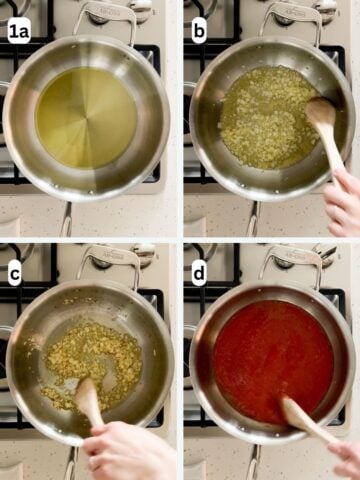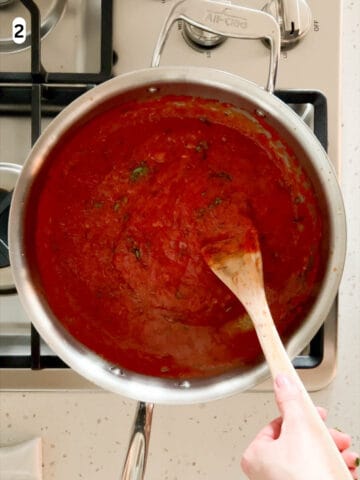Bucatini Pomodoro
Bucatini pomodoro is bursting with bright flavors. The pasta is coated in a classic Italian sauce made with San Marzano tomatoes and fresh basil. It's perfect for a quick weeknight dinner or a special date night meal!
Servings: 8
Calories: 293kcal
Ingredients
Pomodoro Sauce:
- ¼ cup extra virgin olive oil
- 1 small yellow onion (diced)
- 5 cloves garlic (minced)*
- 1 can (28 ounces) San Marzano tomatoes (puréed)*
- 1 teaspoon kosher salt
- ¼ cup fresh basil leaves (chopped, plus more for garnish)*
Pasta:
- 1½ tablespoons kosher salt
- 1 pound bucatini (dried)*
Instructions
- Make the pomodoro sauce: heat the olive oil in a large sauté pan or skillet over medium heat. Add the onion and sauté until soft and translucent, about 3 to 4 minutes. Add the garlic and sauté 1 more minute until lightly golden. Then stir in the tomatoes and the 1 teaspoon of salt.

- Thicken the sauce: simmer the sauce on low to medium heat for about 15 minutes until it thickens. Stir occasionally as it cooks. After it thickens, stir in the fresh basil.

- Cook the pasta: as the sauce simmers, bring a large pot of water to a boil and add 1½ tablespoon of salt. Then add the bucatini and cook extra al dente, about one minute less than the package instructions. Just before the pasta is ready, reserve 1 cup of pasta water and set aside. Then drain the pasta.

- Combine the pasta and sauce: add the drained pasta to the pan with the sauce. Mix together with tongs until the pasta is evenly coated. As you mix, slowly add the pasta water until your desired sauce consistency is achieved, saving any excess for leftovers. Remove from the heat and garnish with more fresh basil and grated parmesan if desired. Serve and enjoy!

Video
Notes
- Garlic: if you don't have fresh garlic you can substitute with garlic powder. Use ¼ teaspoon of garlic powder for each clove of garlic.
- San Marzano tomatoes: authentic San Marzano tomatoes come whole and peeled in the can. To purée them, you can pulse them in a food processor or blender until they reach a smooth consistency. You can also crush them with your hands and break them apart with a wooden spoon as they cook, although the sauce may not be as smooth this way. I prefer using San Marzano tomatoes because they have a rich, sweet flavor that is unmatched. An authentic can of tomatoes is grown in the Campania region of Italy and should have the official Italian DOP symbol and the seal of the San Marzano consortium on the label. If you don't have San Marzano tomatoes, the pomodoro will still be amazing. You can substitute with "San Marzano-style" (same or similar seed but grown outside the designated region) or regular canned tomatoes.
- Basil: you can substitute the fresh basil with dried, using ⅓ the amount. Instead of using ¼ cup of fresh basil, you would use 1 tablespoon plus 1 teaspoon of dried basil.
- Bucatini: you can substitute with the pasta shape of your choice. Other long cuts like spaghetti, fettuccini, or linguine would work well. You can also substitute with a whole wheat, lentil, or chickpea pasta. Cooking times may vary, so follow the package instructions for best results.
- Fresh pasta conversion: substitute 1½ pounds of fresh pasta for every 1 pound of dried. Adjust the cooking time accordingly. Go slow when adding the pasta water to the sauce because fresh pasta absorbs less water. This prevents the sauce from becoming too watery.
- Add crushed red pepper flakes: for a little spice, you can add ¼ teaspoon of red pepper flakes to the sauce. You can do so in step 1 when you add the salt.
- Garnish with grated parmesan: for a pop of umami you can add some grated parmesan cheese on top. The white is a beautiful contrast to the bright red sauce!
- Storage & reheating: store for up to 3 to 4 days in an airtight container in the refrigerator. Refrigerate any extra pasta water and drizzle a bit over the leftover pasta prior to reheating. Any leftovers should be reheated to 165°F (74°C). The pasta can be reheated in a skillet over low to medium heat until warm throughout. You can also reheat it in a microwave in 1 minute increments until it reaches temperature.
Nutrition
Serving: 1cup | Calories: 293kcal | Carbohydrates: 47g | Protein: 8g | Fat: 8g | Saturated Fat: 1g | Trans Fat: 0g | Cholesterol: 0mg | Sodium: 738mg | Potassium: 336mg | Fiber: 4g | Sugar: 4g | Vitamin C: 14mg | Calcium: 50mg | Iron: 1mg
